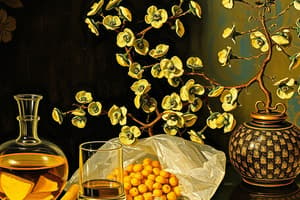Podcast
Questions and Answers
What type of linkage is primarily found in amylose?
What type of linkage is primarily found in amylose?
- α-1,4 linkage (correct)
- β-1,4 linkage
- γ-1,4 linkage
- α-1,6 linkage
Which polysaccharide serves as a storage form of glucose in animals?
Which polysaccharide serves as a storage form of glucose in animals?
- Chitin
- Starch
- Cellulose
- Glycogen (correct)
Which structural polysaccharide is primarily composed of β-(1-4) glycosidic linkages?
Which structural polysaccharide is primarily composed of β-(1-4) glycosidic linkages?
- Inulin
- Glycogen
- Starch
- Chitin (correct)
What is the primary use of cellulose in the human diet?
What is the primary use of cellulose in the human diet?
What elements primarily make up carbohydrates?
What elements primarily make up carbohydrates?
Which feature distinguishes glycogen from starch?
Which feature distinguishes glycogen from starch?
What is the primary function of glycosidic bonds in carbohydrates?
What is the primary function of glycosidic bonds in carbohydrates?
What is the main building block of chitin?
What is the main building block of chitin?
Where is cellulose most commonly found in nature?
Where is cellulose most commonly found in nature?
What distinguishes an O-glycosidic bond from an N-glycosidic bond?
What distinguishes an O-glycosidic bond from an N-glycosidic bond?
Which of the following accurately describes inulin?
Which of the following accurately describes inulin?
What is the general formula for carbohydrates?
What is the general formula for carbohydrates?
Which common carbohydrate is a disaccharide of physiological significance?
Which common carbohydrate is a disaccharide of physiological significance?
What is the significance of pentoses in human metabolism?
What is the significance of pentoses in human metabolism?
Which of the following best describes glycoside formation?
Which of the following best describes glycoside formation?
Which of the following carbohydrates is classified as a hexose?
Which of the following carbohydrates is classified as a hexose?
What is the main function of phosphorylating glycolytic intermediates?
What is the main function of phosphorylating glycolytic intermediates?
Which of the following substances inhibits pyruvate kinase activity?
Which of the following substances inhibits pyruvate kinase activity?
In which situation is anaerobic glycolysis primarily utilized?
In which situation is anaerobic glycolysis primarily utilized?
What role do cofactors like K+ and Mg2+ play in pyruvate kinase activity?
What role do cofactors like K+ and Mg2+ play in pyruvate kinase activity?
Which pathway involves the conversion of pyruvate to lactate?
Which pathway involves the conversion of pyruvate to lactate?
What is the role of aldose reductase in the metabolism of glucose?
What is the role of aldose reductase in the metabolism of glucose?
Which enzyme is responsible for converting sorbitol to D-fructose in certain tissues?
Which enzyme is responsible for converting sorbitol to D-fructose in certain tissues?
What metabolic defect is caused by a deficiency in fructokinase?
What metabolic defect is caused by a deficiency in fructokinase?
Which product is formed when lactose is hydrolyzed?
Which product is formed when lactose is hydrolyzed?
What is the consequence of the absence of aldolase B in metabolism?
What is the consequence of the absence of aldolase B in metabolism?
UDP-galactose is primarily used for which of the following?
UDP-galactose is primarily used for which of the following?
Which condition results from a deficiency in galactokinase?
Which condition results from a deficiency in galactokinase?
What is a consequence of lactose intolerance?
What is a consequence of lactose intolerance?
What is the overall reaction when pyruvate is converted to Acetyl CoA?
What is the overall reaction when pyruvate is converted to Acetyl CoA?
Which factor increases the activity of pyruvate dehydrogenase (PDH) according to the regulatory mechanisms?
Which factor increases the activity of pyruvate dehydrogenase (PDH) according to the regulatory mechanisms?
Which enzyme is key in the oxidative decarboxylation of isocitrate?
Which enzyme is key in the oxidative decarboxylation of isocitrate?
What is produced along with NADH during the conversion of α-ketoglutarate to succinyl CoA?
What is produced along with NADH during the conversion of α-ketoglutarate to succinyl CoA?
What role does citrate play in its own synthesis reaction?
What role does citrate play in its own synthesis reaction?
Which of the following coenzymes is required by the pyruvate dehydrogenase complex?
Which of the following coenzymes is required by the pyruvate dehydrogenase complex?
What type of phosphorylation occurs during the cleavage of Succinyl CoA?
What type of phosphorylation occurs during the cleavage of Succinyl CoA?
How many ATPs are generated from the oxidation of malate to oxaloacetate?
How many ATPs are generated from the oxidation of malate to oxaloacetate?
What is the primary role of hexokinase in glucose metabolism?
What is the primary role of hexokinase in glucose metabolism?
What distinguishes glucokinase from hexokinase?
What distinguishes glucokinase from hexokinase?
Which enzyme is responsible for the conversion of fructose 1,6-bisphosphate into triose phosphates?
Which enzyme is responsible for the conversion of fructose 1,6-bisphosphate into triose phosphates?
What effect does ATP have on the enzyme phosphofructokinase I (PFK I)?
What effect does ATP have on the enzyme phosphofructokinase I (PFK I)?
What is the main purpose of the reaction catalyzed by glyceraldehyde 3-phosphate dehydrogenase?
What is the main purpose of the reaction catalyzed by glyceraldehyde 3-phosphate dehydrogenase?
What occurs during the conversion of 2-phosphoglycerate to phosphoenolpyruvate?
What occurs during the conversion of 2-phosphoglycerate to phosphoenolpyruvate?
Which molecule does phophoglycerate mutase act upon?
Which molecule does phophoglycerate mutase act upon?
What is the role of fluoride in the context of the glycolytic pathway?
What is the role of fluoride in the context of the glycolytic pathway?
Flashcards
Carbohydrates Classification
Carbohydrates Classification
Carbohydrates are classified based on their structure, primarily into simple and complex carbohydrates.
Carbohydrate Structure
Carbohydrate Structure
Carbohydrates consist of carbon, hydrogen, and oxygen atoms, often represented by the general formula Cx(H2O)y.
Monosaccharides
Monosaccharides
The simplest form of carbohydrates, consisting of a single sugar unit.
Disaccharides
Disaccharides
Signup and view all the flashcards
Glycosidic Bonds
Glycosidic Bonds
Signup and view all the flashcards
O-Glycosidic Bond
O-Glycosidic Bond
Signup and view all the flashcards
N-Glycosidic Bond
N-Glycosidic Bond
Signup and view all the flashcards
Glycoside Formation
Glycoside Formation
Signup and view all the flashcards
Starch
Starch
Signup and view all the flashcards
Amylose
Amylose
Signup and view all the flashcards
Amylopectin
Amylopectin
Signup and view all the flashcards
Glycogen
Glycogen
Signup and view all the flashcards
Cellulose
Cellulose
Signup and view all the flashcards
Chitin
Chitin
Signup and view all the flashcards
Inulin
Inulin
Signup and view all the flashcards
Dietary Fiber
Dietary Fiber
Signup and view all the flashcards
Hexokinase vs Glucokinase
Hexokinase vs Glucokinase
Signup and view all the flashcards
Irreversible Step in Glycolysis
Irreversible Step in Glycolysis
Signup and view all the flashcards
Phosphofructokinase (PFK I)
Phosphofructokinase (PFK I)
Signup and view all the flashcards
Aldolase
Aldolase
Signup and view all the flashcards
Glyceraldehyde 3-Phosphate Dehydrogenase (GAPDH)
Glyceraldehyde 3-Phosphate Dehydrogenase (GAPDH)
Signup and view all the flashcards
Substrate Level Phosphorylation (SLP)
Substrate Level Phosphorylation (SLP)
Signup and view all the flashcards
Enolase
Enolase
Signup and view all the flashcards
Fluoride Inhibition
Fluoride Inhibition
Signup and view all the flashcards
Pyruvate Dehydrogenase Complex
Pyruvate Dehydrogenase Complex
Signup and view all the flashcards
What is the main function of the Pyruvate Dehydrogenase Complex?
What is the main function of the Pyruvate Dehydrogenase Complex?
Signup and view all the flashcards
TCA Cycle Input
TCA Cycle Input
Signup and view all the flashcards
TCA Cycle Regulation
TCA Cycle Regulation
Signup and view all the flashcards
Citrate Synthase
Citrate Synthase
Signup and view all the flashcards
Isocitrate Dehydrogenase
Isocitrate Dehydrogenase
Signup and view all the flashcards
Succinyl CoA Synthetase
Succinyl CoA Synthetase
Signup and view all the flashcards
Fumarase
Fumarase
Signup and view all the flashcards
Sorbitol Pathway
Sorbitol Pathway
Signup and view all the flashcards
Galactose Metabolism
Galactose Metabolism
Signup and view all the flashcards
Essential Fructosuria
Essential Fructosuria
Signup and view all the flashcards
Hereditary Fructose Intolerance
Hereditary Fructose Intolerance
Signup and view all the flashcards
Lactose Intolerance
Lactose Intolerance
Signup and view all the flashcards
Non-classical Galactosemia
Non-classical Galactosemia
Signup and view all the flashcards
Galactitol
Galactitol
Signup and view all the flashcards
Pyruvate Kinase
Pyruvate Kinase
Signup and view all the flashcards
Pyruvate Kinase Activation
Pyruvate Kinase Activation
Signup and view all the flashcards
Pyruvate Kinase Inhibition
Pyruvate Kinase Inhibition
Signup and view all the flashcards
Phosphorylated Intermediates in Glycolysis
Phosphorylated Intermediates in Glycolysis
Signup and view all the flashcards
Anaerobic Glycolysis
Anaerobic Glycolysis
Signup and view all the flashcards
Study Notes
Carbohydrates
- Carbohydrates are polyhydroxy aldehydes or ketones and their derivatives.
- They consist of carbon (C), hydrogen (H), and oxygen (O) atoms.
- They are represented by the general formula Cx(H2O)y.
- "Saccharide" comes from Greek, Sanskrit, and Latin words for table sugar.
Classification of Carbohydrates
- Monosaccharides: Classified based on the number of carbon atoms (trioses, tetroses, pentoses, hexoses, heptoses). Further classified as aldoses or ketoses based on functional groups.
- Oligosaccharides: Contain 2 to 10 monosaccharide units.
- Disaccharides (two monosaccharides)
- Trisaccharides (three monosaccharides)
- Etc.
- Polysaccharides: Composed of many monosaccharides.
- Homo-polysaccharides: Composed of the same type of monosaccharides.
- Hetero-polysaccharides: Composed of different types of monosaccharides.
Examples of Monosaccharides
- Trioses: Glyceraldehyde, dihydroxyacetone
- Tetroses: D-erythrose
- Pentoses: D-ribose, D-glucose, D-fructose
- Hexoses: D-glucose, D-fructose, D-galactose, D-mannose
- Importance: Building blocks of other carbohydrates, structural components in nucleic acids, and primary energy source
Examples of Disaccharides
- Sucrose: Glucose + Fructose
- Lactose: Glucose + Galactose
- Maltose: Glucose + Glucose
- Isomaltose: Glucose + Glucose (different linkage than maltose)
- Clinical Significance: Sucrose intolerance, lactose intolerance
Examples of Polysaccharides
- Starch: Storage form of glucose in plants, important in food.
- Glycogen: Storage form of glucose in animals, stored in liver and muscle.
- Cellulose: Structural component of plant cell walls (important dietary fiber).
- Chitin: Structural component of fungal cell walls and insect exoskeletons.
- Dextran: Polysaccharide of glucose varying chain length.
Glycosidic Bonds
- Bonds between monosaccharides.
- Two types: O-glycosidic and N-glycosidic bonds
- Formed when hydroxyl group on one monosaccharide reacts with the hydroxyl group of another.
Cellular Respiration
- Glycolysis: Breakdown of glucose to pyruvate or lactate (cytosolic).
- Citric Acid Cycle (TCA cycle): Further breakdown of pyruvate to Acetyl CoA.
- Oxidative Phosphorylation: Generating most of the ATP in the mitochondria from reduced electron carriers.
Metabolic Fate of Pyruvate
- Pyruvate can be transformed to Acetyl CoA, which is a major building block in the TCA cycle
- Pyruvate can also be converted to lactate by lactate dehydrogenase, crucial for anaerobic conditions.
- Pyruvate can also be converted to oxaloacetate by pyruvate carboxylase important for replenishing citric acid intermediates.
TCA Cycle
- Acetyl CoA enters the TCA cycle.
- Series of reactions leading to the oxidation of acetyl CoA to CO2.
- Important for energy production.
- Important intermediate for synthesis of fatty amino acids and other biomolecules.
Metabolism of Fructose
- Fructose, a component of sucrose.
- Metabolism occurs in the liver, intestinal mucosa, and kidneys.
- Phosphorylation by fructokinase, the major mechanism.
- Cleaved to glyceraldehyde-3-phosphate and dihydroxyacetone phosphate, which enter glycolysis.
- Sorbitol pathway for fructose synthesis.
Metabolism of Galactose
- Lactose hydrolysis produces glucose and galactose.
- Galactose phosphorylated to galactose-1-phosphate, then to UDP-galactose.
- UDP-galactose converted back to UDP-glucose, enters various pathways.
- Galactose also used to synthesize other molecules.
Disorders
- Defects in glycolytic enzymes can lead to various diseases and complications.
- Common defects include those in hexokinase, phosphofructokinase, and pyruvate kinase.
- There have also been described defects in the TCA cycle enzymes and pathways
Alcohol Metabolism
- Alcohol converted to acetaldehyde by alcohol dehydrogenase
- Acetaldehyde converted to acetate by aldehyde dehydrogenase
- NADH levels increase, affecting the balance of pyruvate, lactate, and oxaloacetate -Alcohol's effects on metabolism can lead to hypoglycemia.
Studying That Suits You
Use AI to generate personalized quizzes and flashcards to suit your learning preferences.




